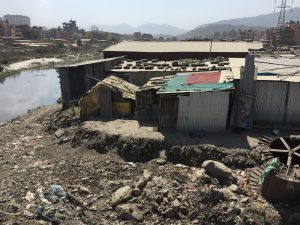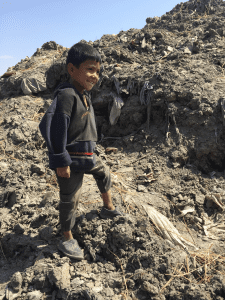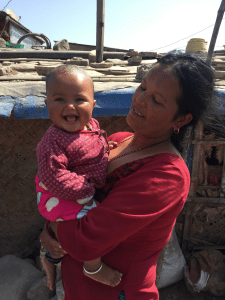 The slum of Danaseri in Kathmandu, Nepal is a sacred place on par with the island of Iona in Scotland, St. Peter’s in Rome, Jerusalem, and Lourdes.
The slum of Danaseri in Kathmandu, Nepal is a sacred place on par with the island of Iona in Scotland, St. Peter’s in Rome, Jerusalem, and Lourdes.
Danaseri doesn’t look like much at the first glance. It looks like a place you wouldn’t want to go to or spend much time in, let alone live in. But with a deeper look, it is in fact a microcosm of planet Earth. And with an even deeper look, it is nothing less than the Kingdom of God come to earth.
The world continues to urbanize at an astonishing rate.
The last time I was in Peru, 27 million people lived in that country and 9 million of them in one city, the capitol Lima. In the early 1970s, there were 150,000 people living in Nairobi, Kenya. By the early 2000s that had grown to almost 4 million, with 75% of those living on 1.5% of the land of the city, in dense slums.
This is not a dynamic foreign to the United States. When I grew up in Northern Virginia in the late 1970s, there were about 2.5 million people living in the metro Washington area. By the new millenium that number had doubled and has continued to grow rapidly.
This is not bad news, in fact it follows the pattern of the Bible, which begins in a garden and ends in a great city, a city that works for the flourishing of all her people with God in the midst. That vision of flourishing in the city for all will come when the Kingdom of God comes to Earth. Until then, most cities are marked by great disparity, hardship, and inequity for their inhabitants. The great and original design for all things was marred by the Fall, twisting things meant for good and making them destructive. In few places is this more evident in cities, and in places like Danaseri.
 What drives this migration to the city? It is simple. Opportunity that translates to money. That is the hope at least. In the rural villages of Nepal, a subsistence farmer might make a dollar a day. In Kathmandu, for the lowest jobs, a person might make 7 dollars a day. This differential can provide for one’s own family, and leave some left over to send back to relatives back in the village.
What drives this migration to the city? It is simple. Opportunity that translates to money. That is the hope at least. In the rural villages of Nepal, a subsistence farmer might make a dollar a day. In Kathmandu, for the lowest jobs, a person might make 7 dollars a day. This differential can provide for one’s own family, and leave some left over to send back to relatives back in the village.
And so people come, from rural areas from all over Nepal and every corner, to Kathmandu. They have no money, and no place to live, and thus the slums are created. There are currently at least 60 slums in Kathmandu.
Danaseri is one of them. In early 2006 it was a bare riverbank, and then people started to come from the villages, and by the end of 2006 there were shanties made of sheets of tin and tarps. Now in 2017 over 400 families call Danaseri home.
The living conditions are awful. It’s built on trash, and mounds even mountains of trash are everywhere, and it smells like it. There is no clean water, there is no sanitation, there is no plumbing, and it smells like it. With the fetid river that slowly moves beside it, the smell is overpowering, especially when the wind blows. In the monsoon season, the river will flood leaving water over every floor where the inhabitants of Danaseri live and sleep. It’s unthinkable for most, except for many it is their life.
Nepalis have come to Danaseri from every corner of the country, seeking a better life for them and for those back home. It is a melting pot of the tribes of the country. And they come, they meet, they marry, and have children. There are many children in Danaseri. Many of them end up begging in the city center and city squares, and come home with their few rupees.
What is their hope?

Bill Haley (left) and Pastor Daniel Pun (right)
Their hope is Jesus, and Jesus with skin on. Here in Danaseri, Jesus with skin on has a name, Pastor Daniel Pun, an Anglican priest.
Daniel came to Danaseri in late 2006 when Nepalis were beginning to arrive in great number. He’d planned to go elsewhere in God’s service and even had a visa to Europe, but in a dream God called him to the children of this community. So he ripped up his visa, came, and stayed.
He began simply by seeking to love and serve the children, offering games and programs and attention. Many children came to know Jesus, and because of them, many of their parents have come to know him as well.
Ten years later, of the 400 hundred families here 200 of them have decided to follow Jesus and committed their lives to him. That number has increased 10% since I was here just nine months ago.
Many of these new Christians–and all of them are new Christians–have decided to follow Jesus because of many miracles and healings, and because of the simple love shown in Jesus’ name. Daniel has opened a school in the slum, teaching kindergarteners and elementary students basic education, and English. He’s opened a computer lab, and planted a thriving church–Revival Church– crammed under a tin roof structure.
Some of those who have come to Jesus in the slum of Danaseri are now preparing go back to their villages and plant churches there, with the financial support of Revival Church. It’s the way the Apostle Paul spread the Gospel–go to the city and you’ll reach the country.
 It’s an amazing thing to be in Danaseri. At first glance it feels hopeless, except that it’s throbbing with hope because of Jesus Christ. Instead of merely a slum, in fact it is a place where the Kingdom of God is coming to earth in real time.
It’s an amazing thing to be in Danaseri. At first glance it feels hopeless, except that it’s throbbing with hope because of Jesus Christ. Instead of merely a slum, in fact it is a place where the Kingdom of God is coming to earth in real time.
Daniel said “I do not call this this a slum…I call it Jerusalem. It is a city of light.”
It’s a vision of the way things are and the way they are meant to be. Where brokenness abounds, it is met with the power of God and becomes a place of thriving for any who would say yes to God’s invitation to salvation and flourishing.
This slum is a sacrament. It is the invisible Kingdom of God being made visible in the broken places of the world.
Daniel’s vision is to lobby the government to get a plot of clean ground, and create a community for the poor where they can thrive in a place far more human than a slum by a fetid riverside.
He’s praying about this, as he’s prayed about all else.
My sense is that, as with everything else, God will hear Daniel’s prayer and answer, and that answer will be even more of a testament to the reality of God, even moreso than what is already happening in Danaseri.
I found Pastor Daniel and our visit to Danaseri to be utterly life-giving, inspiring…even transcendent. It is a focal point on earth of the reality of the world as it is, and the Kingdom of God as it is. Here one sees so clearly that Jesus is not only the hope of those in Danaseri, he is in fact the hope of the world.
Photo Credits: Bill Haley
